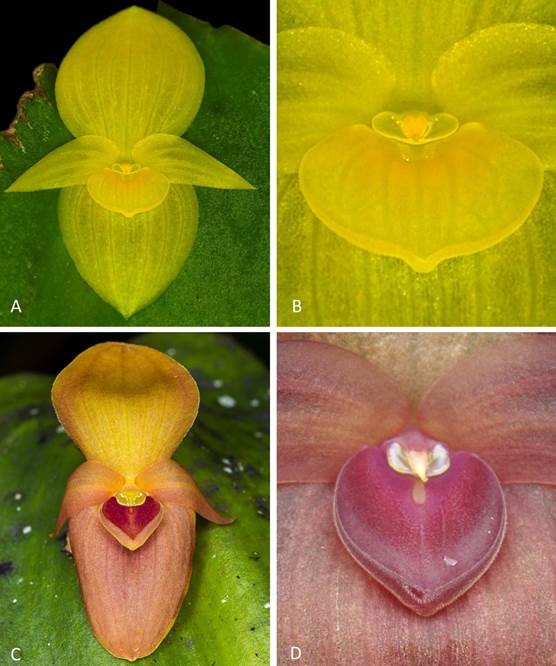Introduction
In the genus Pleurothallis R.Br. sensuPridgeon et al. (2005) there are between 478 and 625 species (Wilson unpubl. data), depending on synonymy, making it the third largest genus in Pleurothallidinae, after Lepanthes Sw. and Stelis Sw. The genus is distributed from Central America and the Caribbean Islands to South America, where most of the species are epiphytes in cloud forests of the Andes (Doucette et al. 2016).
Section Macrophyllae-Fasciculatae Lindl. was created as part of Pleurothallis infrageneric classification by Lindley (1859), which was later considered by Luer (1986) in his initial systematics of genus Pleurothallis and subsequently demoted to a subsection of the same name (Luer 1988). However, in 2005 he resurrected the genus Acronia C.Presl, grouping the subsections Acroniae (C.Presl) Luer and Macrophyllae-Fasciculatae (Lindl.) Luer (Luer 2005). Recently, phylogenetic relationships of Pleurothallis have been evaluated from DNA sequence analysis (Pridgeon et al. 2001, Wilson et al. 2011, 2013, unpubl. data). The studies revealed the close relationship of subsection Macrophyllae-Fasciculatae with the type species Pleurothallis ruscifolia (Jacq.) R.Br. that supports the inclusion of this group within Pleurothallis versus Acronia (Wilson et al. 2016).
Luer (2005) in revision of subsection Macrophyllae-Fasciculatae indicated that members of the group are distinguished by their sessile leaves with a cordate base, single flowers with lateral sepals connate into a synsepal, and a bilobed stigma. Since Luer’s revision, about a dozen new species have been described in this group, bringing the number to between 236 and 305 species, depending on synonymy (Wilson unpubl. data).
Northwestern Ecuador has been the source of several new orchid discoveries in the recent years. Exhaustive exploration carried out in the forests of El Carchi Province, near the Colombian border has resulted in the discovery of species like Porroglossum raoi Baquero & Iturralde and Platystele baqueroi Jost & Iturralde. In 2016, Luis Baquero found an unknown species of Pleurothallis from subsection Macrophyllae-Fasciculatae in this area. This species with intense, yellow flowers and cordate lip is described here.
Taxonomy treatment
Pleurothallis chicalensis M. Jiménez & Baquero, sp. nov. (Figure 1, 2A-B).
TYPE: Ecuador: El Carchi Province, near Cerro Colorado, Chical-El Carmen road, 00°54.74’N, 78°12.34’W, 1590 m, 4 June 2016, LB 3033 (holotype, QCNE!).
Diagnosis: Similar to Pleurothallis dewildei Luer & R. Escobar, from which it differs in the ovate leaves, the yellow flowers with broadly obovate synsepal and the widely cordate, apiculate lip with involute margins versus the narrowly ovate leaves, purple flowers with ovate synsepal and the broadly cordate- ovate lip with obtuse, saccate apex of P. dewildei.
Plant medium in size, ca. 20 cm tall, epiphytic, caespitose. Roots numerous, slender ca. 1 mm wide. Ramicauls green, erect, slender, 10-30 cm long, enclosed by a tubular, brown sheath running through the second third from the base, and 1-2 other tubular sheaths near the base. Leaf green above, microscopically papillate, dull, light green underneath, perpendicular to the ramicaul, coriaceous, ovate, acuminate, 7-18 × 4-8 cm, edge entire, the base sessile, deeply cordate, with lobes connate for 1 cm. Inflorescence a solitary flower, resupinate, produced successively from a reclining spathaceous bract ca. 1 cm long; peduncle ca. 3-5 mm long concealed within the spathe, floral bract 3 × 2 mm, pedicel ca. 6 mm long. Ovary 5 mm long, clavate, almost straight. Flower 20-23 × 13-18 mm, bright- yellow. Sepals glabrous to microscopically papillose; dorsal sepal ovate, 12-13 × 8 mm, 9-veined, obtuse, margin microscopically glandulous; synsepal broadly obovate, 10-11 × 8-9 mm, 10-veined, subacute, margin microscopically papillous. Petals obliquely triangular-ovate, acute, 7-8 × 2.0-2.5 mm, 3-veined. Lip broadly cordiform, obtuse with a minute rounded apiculus, 4 × 4-5 mm, 5-veined, with involute margins starting near the middle towards the apex, microscopically pubescent; the base subtruncate with a short, deflexed claw, hinged to the column-foot; glenion a small depression between the basal lobes of the lip, surrounded by a slightly convex disc, thickened to the sides. Column stout, yellow-green, 2.0 × 1.6 mm, stigma bilobed. Anther cap apical, yellow, narrowly deltoid. Pollinia 2, narrowly ovoid.
Paratype: Cerro Oscuro, near Chical, 00°54.445’N, 78°11.63’W, 1499 m, 29 October 2016, Baquero 3065 (paratype: QCNE!, flowers preserved in alcohol).
Eponymy: Named after Chical, a small town in El Carchi Province of Ecuador close to the type locality.
Distribution and habitat: Pleurothallis chicalensis has been found in two localities, close to Cerro Colorado on the Chical-El Carmen road and in Cerro Oscuro near the small town of Chical (Figure 3). Two individuals were found growing at the type locality and a population of fifteen plants was found at the second locality. It was also found around La Planada Natural Reserve, Department of Nariño in southwestern Colombia (Figure 3), based on a color photograph in the book Orquídeas en la Niebla (Orejuela 2011). The color and morphology of flowers is consistent between populations.
Pleurothallis chicalensis is sympatric with P. imperialis Luer and P. crucifera Luer & Hirtz, two species confined to northwestern Ecuador. In Cerro Oscuro it is also found with Scaphosepalum swertiifolium (Rchb.f.) Rolfe, S. cimex Luer & Hirtz and other pleurothallids. Near Cerro Colorado, it is found growing next to P. imperialis, P. crucifera, Sobralia lancea Garay, S. crocea (Poepp. & Endl.) Garay, S. macrophylla Rchb.f. and S. ecuadorana Dodson.
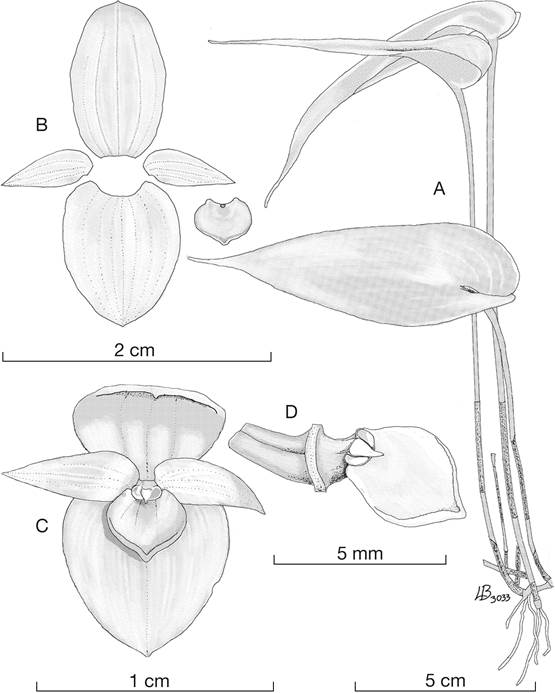
Figure 1 Pleurothallis chicalensis Jiménez & Baquero A. Habit. B. Dissected flower. C. Flower close-up. D. Column and lip, lateral view. Illustration by Luis Baquero based on the holotype.
Conservation status: Both Ecuadorian localities are near the Colombian border, however, the plants at the type locality are threatened by road works, while the population of Cerro Oscuro is protected in Ecominga’s Dracula Reserve. The status of the population near La Planada in Nariño, Colombia is unknown. Until further assessment can be performed, the species should be considered “data deficient” (DD) under IUCN criteria.
Discussion
Due to morphology and geographic proximity, P. chicalensis is probably most closely related to P. dewildei (Figure 2C-D, 4-5), P. bovilingua Luer & R. Escobar (Figure 4-5), and P. calolalax Luer & R. Escobar (Figure 5). The vegetative and floral features shared are the unusually wide, obliquely triangular petals and the wide lip, which is remarkable in species of Macrophyllae-Fasciculatae subsection. However, P. chicalensis is easily recognized in this group of species inside the subsection, by the uniformly bright yellow flowers and the broadly cordate shape of the lip. Other significant differences between these species are detailed in the Table 1.
Table 1 Comparison of Pleurothallis chicalensis to P. dewildei and P. bovilingua.
| Plant part | P. chicalensis | P. dewildei a | P. bovilingua a |
|---|---|---|---|
| Leaves | Ovate, 7-18 × 4-8 cm | Narrowly ovate, 10-15 × 3.0-4.5 cm | Narrowly cordate-ovate, 9-20 × 2.5-5.0 cm |
| Flowers | Bright yellow | Purple, dorsal sepal purple to yellow | Light rose-brown, lip darker |
| Synsepal | Broadly ovate, obtuse, 10-11 mm × 8-9 mm | Ovate, subacute synsepal, 17 × 12 mm | Ovate, acute, 24-25 mm × 17.0 mm, 8-veined |
| Lip | Broadly cordiform, 4 × 4-5 mm, 5-veined, with involute margins, apiculate | Broadly cordate-ovate, 6.0 × 5.5 mm, apparently 3-veined, concave with involute margins above the middle, obtuse | Ovate, 7 × 6 mm, apparently not veined, acute, incurved |
a Obtained from Luer (1998).
Both P. chicalensis and P. dewildei occur in the Pacific slopes of the Andes (Figure 3). The type locality for P. dewildei is south of Pueblo Rico, Risaralda, Colombia, on the Pacific slope of the Western Cordillera (Luer 1998) (Figure 3). Unfortunately, P. bovilingua was described without collection data.
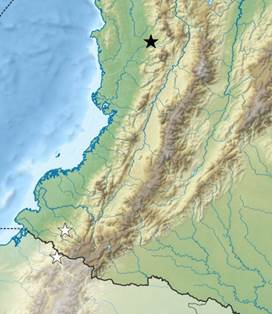
Figure 3 Distribution of Pleurothallis chicalensis (white stars) in Ecuador and Colombia and P. dewildei (black star) in Colombia.
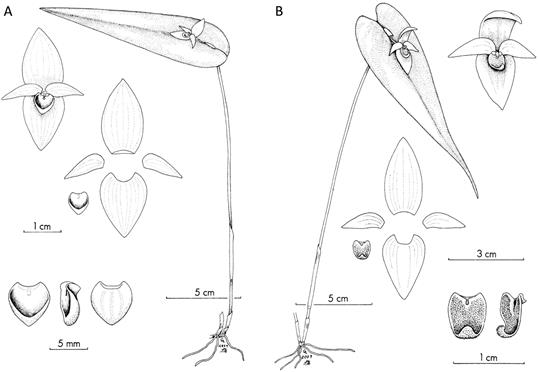
Figure 4 Drawings of A. Pleurothallis dewildei and B. Pleurothallis bovilingua (Reproduced from Luer (2005) courtesy of Missouri Botanical Garden Press).
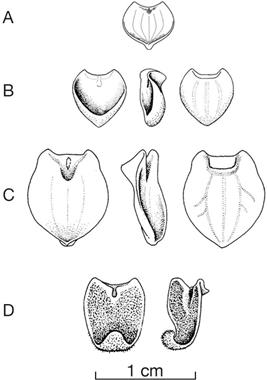
Figure 5 Lip drawings. A. Pleurothallis chicalensis, frontal view. B. Pleurothallis dewildei, frontal, lateral and ventral view. C. Pleurothallis calolalax, frontal, lateral and ventral view. D. Pleurothallis bovilingua, frontal and lateral view. (Modified from Luer (2005) courtesy of Missouri Botanical Garden).












 uBio
uBio 
